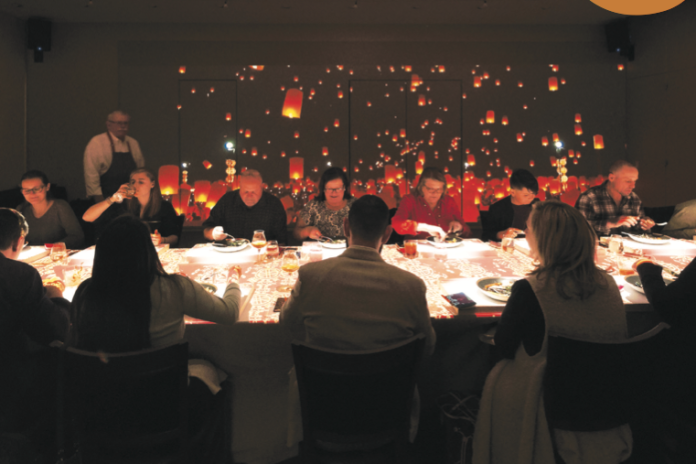No wonder spice inspired Marco Polo’s adventures. A little goes a long way, much like Le Petit Chef, who guides the palates of diners on a global tour of the Silk Road via a three-dimensional dining experience at the Culinary Institute of America (CIA) at Copia in Napa.
The “Spice Trail of Marco Polo” journey leads participants through the wonders of augmented reality via light projection tech dubbed TableMation, literally turning the pages of history and sharing a story about five indigenous courses of spice-infused specialties.
All was dark when I entered the private dining area—except for the table settings, which were lit circles of vignettes the size of dinner plates. The lights hovered over actual books titled Dinner Time Stories. I took my seat next to a woman who introduced herself as Syeda, originally from Pakistan. My dining companions consisted of a mix of local residents, as well as intrepid travelers. We opened our books to blank pages and the scene was set, thanks to Skullmapping, a visual-storytelling technique developed in Belgium.
Zach, our human host for the evening, worked with Le Petit Chef to lead us through each course with a humorous, yet educational, tale to share the footsteps of “that crazy Italian Marco Polo” who discovered spices and exotic cuisine en route to the Silk Road.
Background music and Le Petite Chef’s squeaky techno French accent narration conveyed the story, along with dimension-enhancing visuals. The animation on our pages jumped as he began in Marseilles, France—his birthplace. Once the pages turned and the introduction was made, waiters placed an actual, travel-sized piece of hand luggage at each table setting. We opened the luggage to a taste of Piquillo Gougere Tart, a savory pâté a choux infused with red pepper. Our two-sip cups of tomato soup, paired with glasses of Brut Rosé from Domaine Carneros, were a nice touch.
From Marseilles, we sailed through ocean waters as each plate, and then the table, projected the sea, with waves crashing against the wall for added effect. Amid the thrill of the light show on the wall and the lively conversation among this communal table of diners, the delectable food and wine competed for my attention.
Onward to Arabia, where the table settings metamorphosed into a light show of scroll designs with a batik-blue background. Cartoon smoke from a cartoon hookah puffed over Le Petit Chef while the wall shifted into a desert scene with camels led by men wearing headscarves. Le Petit Chef humorously identified the camels as “big dogs” and then plucked a large red pepper that caused smoke to shoot from his ears. He ran across the book’s pages, madly plunging his face into a half-cut fig for relief.
Then, each of us received a portable tray laid carefully over our individual books, while we passed a handful of cloth bags between us. We played a blind guessing-game on what spices were in each bag. Every diner participated. Some aromas, like cloves and cinnamon, were easy to identify; others, like bay leaf, cardamom and fenugreek—not so much.
We were then asked to identify how these spices factored into our meal and the answers flowed like the complimentary sparkling wine served before dinner. The majority of us correctly identified “cardamom” in the room-temperature lamb meatballs, and a sprinkling of cinnamon over the bed of apricot chutney they were served on.
A few goat-cheese blinis and a sparse portion of lentil stew later, we finished the course with sips of a 2016 Joseph Burrier, Chateau de Beauregard, “Poncie” Fleurie AC paired with tiny bowls of candied hazelnuts and sumac-coated plums.
As our culinary journey continued into India, I devoured a decent portion of Halibut Masala served over a spread of curry with a golf ball–sized Indian eggplant, a few cashews and green peas. With this course, we sipped on a 2017 ZD Chardonnay from Napa Valley and sailed forward.
A palate cleanser of yogurt and a scoop of CIA’s own garden-strawberry sorbet, served in a teacup, awaited each of us at the Himalayas. They told us to restrain from eating this until instructed. Waiters distributed tiny pitchers of hot water to our trays and we carefully poured the water around the small saucer—not in the teacup. This resulted in a “smoke effect,” thanks to the clever use of dry ice, adding drama to the sorbet course.
Upon our arrival in China, dragons displayed on our plates, table and the wall chased Le Petit Chef. We also noticed our live staff of servers now wore red frocks.
While in China, a glass of 2017 Abiouness Pinot Noir from Stanly Ranch in Carneros paired nicely with our next course: a few slices of duck breast and delicious, transparent sweet-potato noodles and a few soybeans, baby carrots and enoki mushrooms.
Dessert was a mix of all the places and the spices we experienced throughout dinner—a cardamom cake, vanilla crème brûlée and a glass of Alvear, “Solera 1927” Pedro Ximenez Sherry, Montilla-Moriles DO, NV for those who purchased the wine pairings with the experience (an additional $50).
We departed with much laughter, newfound friends, bellies filled with food and a better understanding of the spices found along the Silk Road.











